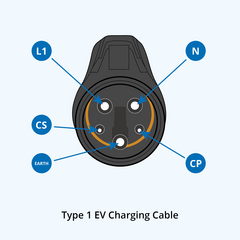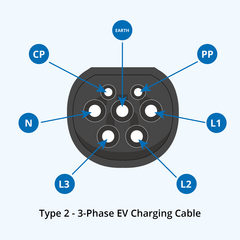1-Phase vs 3-Phase EV Charging: Main Differences
Last updated:
Single-phase and three-phase charging are often mentioned together with the charging power. But where is exactly the connection? And why knowing the charging rate of your car and EV charger isn't enough? We’ll explain it in this blog post.
1-Phase vs 3-Phase Charging Process
What’s happening during charging? Electricity flows from the power grid through the EV charger and into your electric car. And here, we come to the main distinction between the phases.
- 1-phase charging: Power flows through a single conductor (wire). Max charging power - 7.4 kW (In some countries, single-phase charging is only permitted or possible at lower charging power.
- 3-phase charging: Power flows through three conductors (wires). Max charging power - 11 or 22 kW.
So basically, the number of phases your car has only plays a role during AC charging. When using a DC charging station, only the max DC charging power of your electric vehicle and the charging station matters.
Electric Vehicles with a Single-Phase vs Three-Phase On-Board Charger
Every electric vehicle has a predefined number of phases for charging, and so does every AC charging station.
Examples of electric cars with a single-phase on-board charger: Opel Corsa-e in the basic configuration, Mazda MX-30
Examples of electric cars with a three-phase on-board charger: Audi e-tron, Renault Zoe, Tesla Model X, BMW i3.
Ideally, you should use a charging station with the same number of phases as your vehicle has. But it’s not always the case. So what happens if you’ve got one of the following combinations?
- 1-phase charger - 3-phase electric car
- 3-phase charger - 1-phase electric car
Your car will charge with one phase in any of these cases. The weakest link of the charging chain defines the max speed.
Here, for example, you can see how it works with our go-e Chargers:
| go-e Charger 11kW | go-e Charger 22kW | Remark | |
|---|---|---|---|
| Single-phase charging car | 1,4 kW - 3,7 kW | 1,4 kW - 7,4 kW | Country-specific limitations need to be observed |
| Two-phase charging car | 2,8 kW - 7,4 kW | 2,8 kW - 14,8 kW | Two-phase connection of charger not possible |
| Three-phase charging car | 4,2 kW - 11 kW | 4,2 kW - 22 kW | go-e Charger switches through the power that is available at the connection |
Note: A few electric vehicles on the market, including the VW e-Golf and Škoda Enyaq iV 50, can be charged via 2 phases. If you want to enjoy the max charging power with them, you need a three-phase charger. Two-phase chargers simply do not exist.
What Role Does Your Power Grid Play?
You’ve got a powerful three-phase EV charger, and your vehicle can charge with three phases. The perfect combo. Wait, one more thing can be a limiting factor, power grid capacity. When you are at home, you only have a limited amount of energy that you can call on once at a time. If the limit is exceeded, the whole house may black out.
The electricity meter in your house will allow you to find out how many phases are available for charging.
- If the meter says 220 / 230V, this means you can have only a single-phase connection.
- If you see 3×220 / 230V, 380 / 400V, or 380V, you can use all three phases.
Smart home chargers offer load balancing features to prevent blackouts. This means that the charger uses only a safe amount of energy.
Single and Three-Phase Chargers: Which Wallbox Do You Need?
Single-phase smart chargers are sometimes slightly cheaper than three-phase chargers, with a nominal difference of around EUR 40-50. However, given that high-quality chargers usually cost from EUR 700, this “discount” is not really significant. For instance, our go-e Charger costs EUR 749-759 depending on the charging capacity, given that all of our models can work with three phases. And if your car only supports one phase, the go-e Charger will automatically adapt to it. In addition, most manufacturers do not differentiate the price based on the number of phases.
Reasons to buy a single-phase charger
-
Sufficient for a home with a single-phase electrical connection
-
Sufficient for vehicles incapable of three-phase charging
-
Might be slightly cheaper
Reasons to buy a three-phase charger
-
Maximises charging power for vehicles capable of three-phase charging, resulting in faster charging
-
Future-proofs your investment, as your next vehicle may support three-phase charging
-
Ideal for commercial and industrial settings with three-phase power infrastructure
Single and Three-Phases Chargers from go-e
go-e Charger Gemini flex 11 kW
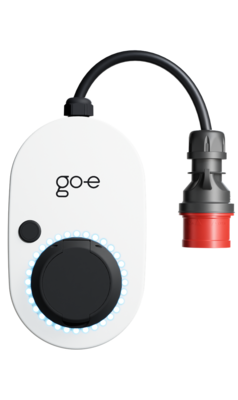
The intelligent wallbox can be used both stationary in the wall bracket and mobile. No electrician is required for the installation of the charging station. Charging power from 1.4 kW to 11 kW. 1-phase or 3-phase charging.
go-e Charger Gemini flex 22 kW
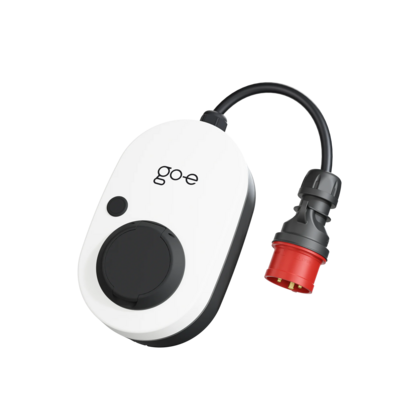
The intelligent wallbox can be used both stationary in the wall bracket and mobile. No electrician is required for the installation of the charging station. Charging power from 1.4 kW to 22 kW. 1-phase or 3-phase charging.
go-e Charger Gemini 11 kW
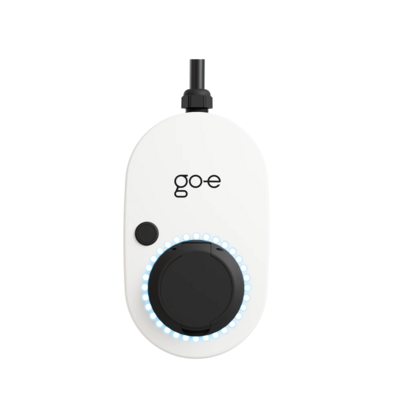
The compact wallbox for stationary use, at home or at the workplace. Simple installation, intuitive operation and smart comfort functions. Charging power from 1.4 kW to 11 kW. 1-phase or 3-phase charging.
go-e Charger Gemini 22 kW

The compact wallbox for stationary use, at home or at the workplace. Simple installation, intuitive operation and smart comfort functions. Charging power from 1.4 kW to 22 kW. 1-phase or 3-phase charging.
Charging Cables for Single vs Three-Phase Charging
The cable you use for charging can limit your charging power as well. If you’ve read our cable buyer’s guide, you know that there are several types of them.
Type 1 charging cables for single-phase charging only
These are rather rare. Only some car models such as Kia Soul EV, Citroen C-Zero, Peugeot iOn and a few others have a charging port for this type of cable. What you need to know about the type 1 cable is that it is suitable for single-phase charging only and its maximum power output is 7.4 kW.
Type 2 charging cables for single and three-phase charging
As with wallboxes, there are type 2 cables that support three-phase & single-phase charging and type 2 cables that only support single-phase charging.
To pick the right one, make sure it supports at least as many phases as you need for your car charging, matching what your car and wallbox can handle. For instance, if you want and have the opportunity to enjoy three-phase charging, opt for a three-phase charging cable.
But how do you figure out how many phases a cable supports?
You can either read about it in the cable instructions or take a look at its plug (the end that goes into the car socket). If it supports three phases, all of its 7 pin holes have the same filling. If only one phase is available, two lower pins look like they are empty.
Alternatively, you can buy a type 2 cable from the go-e shop and be sure it supports three-phase charging. We offer them in three different lengths: 2.5, 5 and 7.5 m.
It's smart to be ready for the future and always have the option to charge with all three phases. For example, if you have a single-phase electrical connection at home, installing a three-phase wallbox wouldn't be practical. However, you can still take advantage of a type 2 cable with three phases at a public AC charging station to access full power charging. Typically, you'd need to use your own cable in these situations.
Note: In addition to supporting 3-phase charging, a 3-phase cable can also be used for single-phase charging.
Summary
Even though there are several links in the charging chain, the main factor in your decision-making should be your electric car, of course. Find out how many phases it supports and choose a suitable EV charger and charging cable. If the power grid in your home does not allow you to reach the maximum charging power (e.g., your house has old electrics), upgrading it might be the solution.
